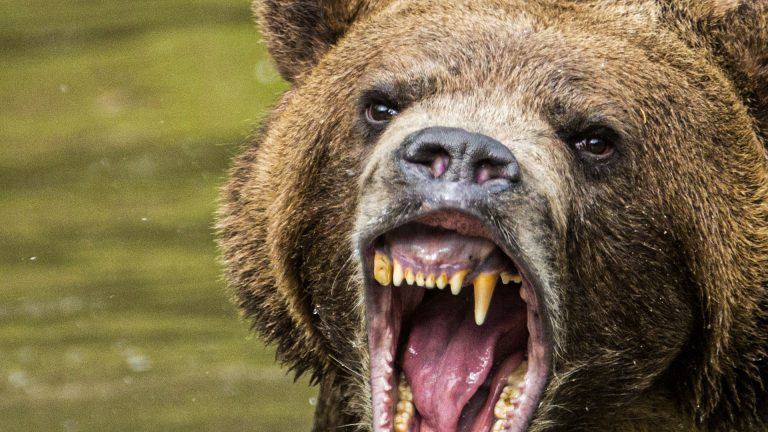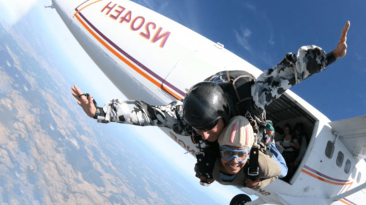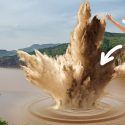For most people, bear encounters don’t look anything like that. More like this. And that is exactly the type of behavior that might get you killed.
If you go for a hike in the forest, bears shouldn’t be your biggest concern. They don’t normally attack people for no apparent reason. Not unless they’re starving, or you get too close to a cub.
But if you do meet a bear that’s mad at you about the intrusion, what should you do? Should you run for your life? Pretend to be dead? Attack it before it attacks you? Luckily for you, we’ve got four steps to help you get out of a bear’s claws alive.
Step one. Identify the bear
The first thing you should know about bears is they ain’t all the same. Before choosing your survival strategy, you have to figure out what kind of bear you’ve encountered.
To make things even more fun, let’s take the biggest, male bears, and enter them in a boxing match. Our number one bear is the brown bear, or grizzly. He has brown medium to dark fur, round ears, a hump above the shoulder, and long claws. His body length reaches 2 m (6.5 ft).
Moving on to number two, the black bear. His distinguished features are a straight facial profile, tall ears, and short claws. No hump above the shoulder. The body length of 1.5 m (5 ft) makes him smaller than your other opponent.
Finally, the polar bear. Thick, white fur, short tail, and massive paws. His body stretches up to a whopping 3.3 m (11 ft).
Step two. Read the room
Not all bears are going to attack you on sight. For example, black bears aren’t as aggressive as grizzlies, unless they feel threatened. But if you find yourself alone in the Arctic, and a polar bear is charging at you, today is not your lucky day. To a polar bear, you’re prey at first sight.
Step three. Use the first line of defence, bear spray.
If you like to walk around the forest with a firearm in your hands, I have news for you. There are things more effective against a bear. Bear spray works on all bears.
You should keep it in your front pocket any time you go into bear territory. Because if, say, a brown bear attacks you, you’ll only have a few seconds to fire. So pull yourself together, steady your arms, and aim for the bear’s nose, eyes and mouth. Wait until he is 10 m (30 ft) away, and spray for about 2 seconds. Then retreat as soon as possible. But what if you didn’t plan for a bear spray? What should you do then?
Step four. Choose your survival strategy
If you end up on a date with a black bear, you might be relatively safe. But don’t ruin the moment by climbing up a tree. Black bears are much better climbers than you are. And don’t try to play dead. Black bears don’t fall for that.
Instead, hit the bear with a stick, throw stones at him, show him who’s boss. With grizzlies, it’s different. You don’t want to run from a brown bear. He’ll catch you and eat you before you know it. Your best bet is to fall in the fetal position, and protect your head, neck, and stomach. That’s what I call playing dead.
If a grizzly doesn’t feel threatened, he’ll leave. But don’t rush to get up. Stay down for at least 20 minutes after an attack, in case the bear didn’t really buy your acting.
But what about a polar bear? Do you even stand a chance?
Polar bears won’t get fooled as easily by your intimidation act. Fighting a one-ton polar bear isn’t a great idea either. Once again, bear spray is your best bet. But if you do end up fighting a polar bear, attack as if your life depends on it. Because it does. Try to aim for the nose or eyes. And watch out for those deadly paws.
Ultimately, the best way to survive is to avoid an encounter in the first place. Fortunately for you, most bears will retreat before you even know they’re there.
A forest can be a dangerous place, even when bears aren’t involved. Everything looks the same and, wait, did I pass this tree already? Am I lost? Alone? In the forest?
Subscribe to What-If on YouTube or follow the show on Facebook Watch.
Sources
- “Staying Safe Around Bears – Bears (U.S. National Park Service)”. 2020. nps.gov.
- “Bear-Inflicted Human Injury And Fatality”. Floyd, Timothy. 1999. Wilderness & Environmental Medicine 10 (2): 75-87. doi:10.1580/1080-6032(1999)010[0075:bihiaf]2.3.co;2.
- “BYU Study: Using a gun in bear encounters doesn’t make you safer”. News.
- “Black Bear”. 2020. cwf-fcf.org.
- “Black Bear”. 2020.


















